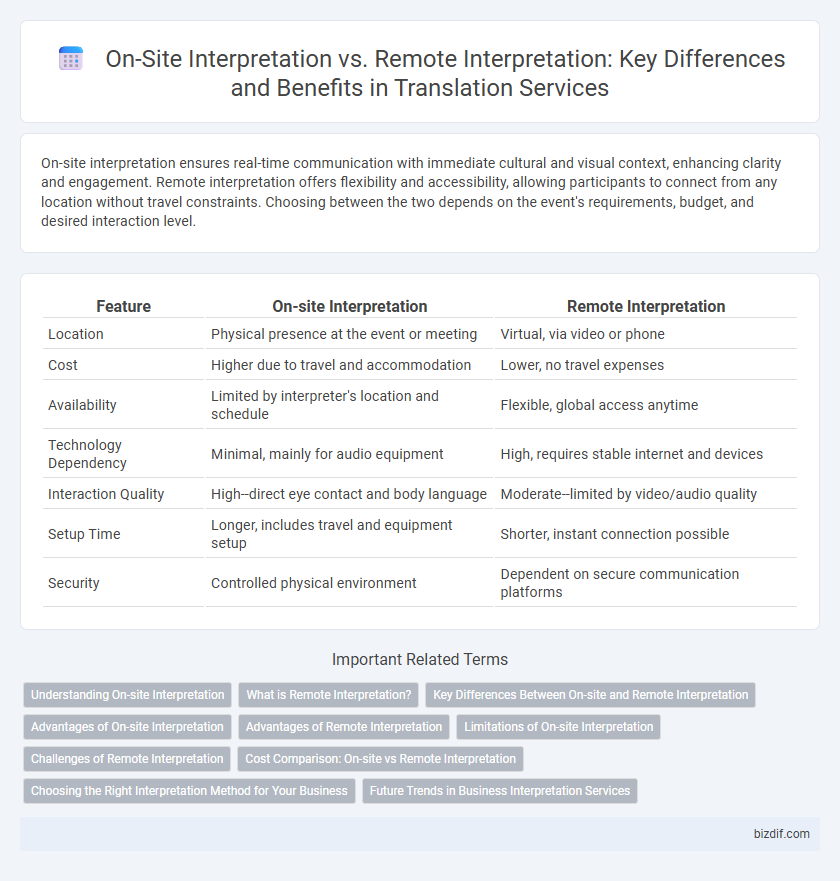On-site interpretation ensures real-time communication with immediate cultural and visual context, enhancing clarity and engagement. Remote interpretation offers flexibility and accessibility, allowing participants to connect from any location without travel constraints. Choosing between the two depends on the event's requirements, budget, and desired interaction level.
Table of Comparison
| Feature | On-site Interpretation | Remote Interpretation |
|---|---|---|
| Location | Physical presence at the event or meeting | Virtual, via video or phone |
| Cost | Higher due to travel and accommodation | Lower, no travel expenses |
| Availability | Limited by interpreter's location and schedule | Flexible, global access anytime |
| Technology Dependency | Minimal, mainly for audio equipment | High, requires stable internet and devices |
| Interaction Quality | High--direct eye contact and body language | Moderate--limited by video/audio quality |
| Setup Time | Longer, includes travel and equipment setup | Shorter, instant connection possible |
| Security | Controlled physical environment | Dependent on secure communication platforms |
Understanding On-site Interpretation
On-site interpretation involves a professional interpreter physically present at the event location, ensuring direct, real-time communication between parties speaking different languages. This method enhances accuracy and cultural nuance by allowing interpreters to read body language and environmental cues, which are critical for effective communication. Industries such as legal, medical, and conference settings often rely on on-site interpretation to maintain confidentiality and immediacy.
What is Remote Interpretation?
Remote interpretation enables real-time language translation through digital platforms, eliminating the need for interpreters to be physically present. This method leverages video conferencing, phone lines, or specialized apps to facilitate seamless communication across diverse locations. Remote interpretation enhances accessibility and reduces travel costs, making it ideal for international meetings, virtual conferences, and emergency situations.
Key Differences Between On-site and Remote Interpretation
On-site interpretation involves interpreters physically present at the event location, ensuring direct interaction and immediate contextual understanding, while remote interpretation operates through digital platforms, offering flexibility and reduced travel costs. Key differences include the immediacy of communication, with on-site enabling real-time visual cues and remote relying heavily on audio-visual technology. Technical requirements and potential connectivity issues in remote setups contrast with the controlled environment of on-site interpretation, impacting accuracy and overall experience.
Advantages of On-site Interpretation
On-site interpretation offers direct, real-time communication that enhances accuracy and cultural nuance in interactions, crucial for complex negotiations and sensitive topics. The physical presence of interpreters fosters stronger trust and rapport between parties, improving overall communication effectiveness. On-site settings also allow immediate adaptation to environmental cues and technical issues, ensuring seamless language support throughout the event.
Advantages of Remote Interpretation
Remote interpretation offers unmatched flexibility by enabling seamless communication across diverse geographic locations without the need for travel, reducing costs and time constraints. It provides immediate accessibility to specialized interpreters worldwide, ensuring linguistic accuracy and cultural relevance in various industries. Advanced digital platforms equipped with real-time audio and video capabilities enhance the quality and efficiency of remote interpretation services.
Limitations of On-site Interpretation
On-site interpretation faces limitations such as higher costs, logistical challenges, and limited availability of qualified interpreters in remote locations. It also restricts flexibility, as interpreters must be physically present, leading to scheduling constraints and potential delays. Technical and environmental factors at the site can further impact interpretation quality and effectiveness.
Challenges of Remote Interpretation
Remote interpretation faces significant challenges such as unstable internet connections, latency issues, and limited non-verbal communication cues that can affect the accuracy and fluidity of the translation. Technical difficulties, including audio quality problems and equipment malfunctions, often disrupt the interpreter's ability to deliver seamless services. These factors increase the risk of misunderstandings and reduce the overall effectiveness compared to on-site interpretation.
Cost Comparison: On-site vs Remote Interpretation
On-site interpretation typically incurs higher costs due to travel, accommodation, and venue expenses, making it less budget-friendly for prolonged or multiple sessions. Remote interpretation reduces overhead by eliminating physical presence, allowing flexible scheduling and cost savings on logistics. Companies often find remote services more scalable and economical while maintaining accurate, real-time communication.
Choosing the Right Interpretation Method for Your Business
Choosing the right interpretation method depends on your business's specific needs, budget, and event format. On-site interpretation provides face-to-face interaction and immediate cultural context, ideal for conferences and negotiations requiring personal engagement. Remote interpretation offers flexibility, cost-efficiency, and scalability for virtual meetings or multi-location events, ensuring seamless communication across global teams.
Future Trends in Business Interpretation Services
Future trends in business interpretation services emphasize the integration of advanced AI-driven remote interpretation platforms that enhance real-time accuracy and multilingual support. On-site interpretation remains essential for high-stakes negotiations and cultural nuances, but hybrid models combining both methods are gaining traction for flexibility and cost-efficiency. Growth in cloud-based interpretation tools and 5G connectivity will further streamline communication in global business environments.
On-site Interpretation vs Remote Interpretation Infographic

 bizdif.com
bizdif.com